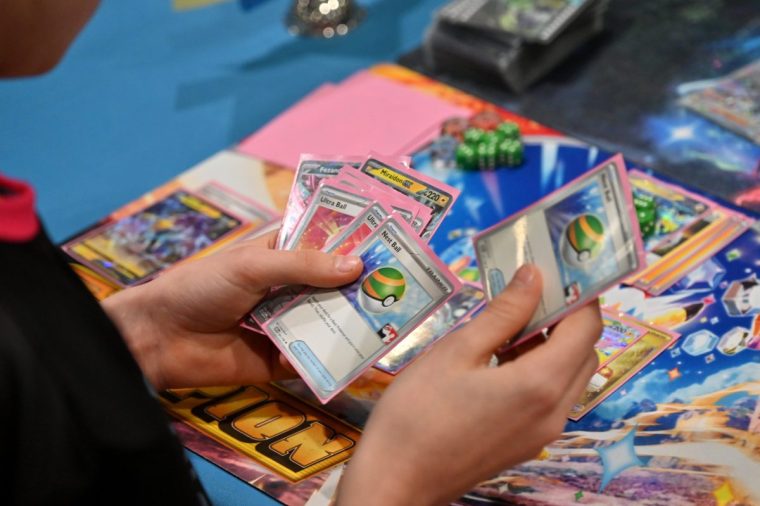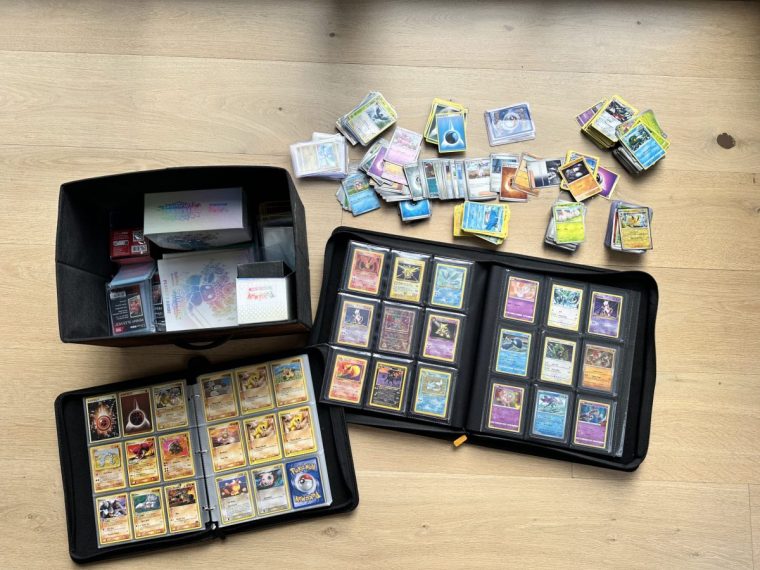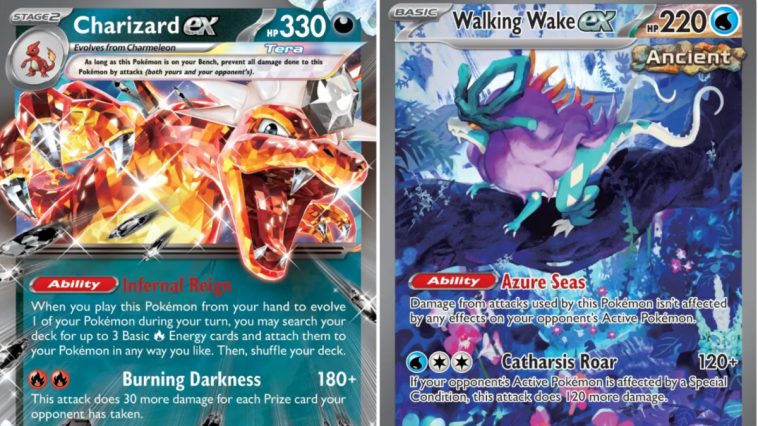Sam realised his Pokémon card infatuation had returned when his letterbox began to resemble Harry Potter’s house. “It was like all those envelopes flying down the Dursley chimney,” the 28-year-old recruiter laughs, explaining that he often doesn’t remember what he ordered until they hit the doormat. “It’s an absolute obsession.”
He’s not alone. Decades since they first emerged, Pokémon cards are more popular than ever. Trading is booming; resale site StockX is experiencing triple-digit sales growth year-on-year (up 367 per cent in 2025); sales on Whatnot UK, a live-streaming auction website, have doubled over the past six months; and events like August’s London Card Show and Cards & Collectables, in Manchester, are bringing them to the masses.
Pokémon cards first burst onto the scene in October 1996, as collectable cards to run alongside Pocket Monsters, a video game where users could catch fictional creatures, each with special powers, released on Game Boy earlier in the year.
The Pokémon card game was designed to be strategic. Each card is dedicated to a different Pokémon – from Pikachu to Jigglypuff – and lists their attributes, ranging from their Elemental Type (such as Fire, Water or, er, Bug) to their Attacks (of which there are 460 in total). You’d need to take a day off work to learn the whole spiel, but it essentially works like a souped-up game of Top Trumps: cards and creatures fight and compete with one another.

By 1999, it was the second most popular collectable card game (behind geeky fantasy staple Magic: The Gathering) and, for many people, simply collecting as many cards as possible became much more exciting than battling. The tagline is, of course, “Gotta Catch ‘Em All!” – and with 17,000 unique Pokémon cards in existence, there’s a hefty stack to accumulate.
The cards are a familiar sight for 90s kids, filed next to playground classics such as Tamagotchi, Beyblades and those weird alien eggs that supposedly reproduced in your fridge. “I initially started collecting Pokémon cards in primary school when Pokémon first hit the UK,” says 31-year-old teaching assistant Harry Coleman. “I had a massive pile I would take to school with an elastic band wrapped around them.” He regularly fell out with his brother over which cards they should trade (important lesson: it’s a lot easier to be a solo collector).
I also fondly remember the initial hype. Every weekend, I’d hang out at a comic shop in Sutton, South London, to spend the entirety of my pocket money on Yu-Gi-Oh and Pokémon cards. My dad couldn’t understand why I’d spend £3 on a pack of nine flimsy pieces of paper – and then immediately banish the bad ones to the cardboard graveyard of my bottom drawer.
But most of us grew out of it. So why, years later, are so many past enthusiasts suddenly dusting down their booklets? No one is safe from the frenzy; even Simon Cowell stuffed his ludicrously high-waisted trouser pockets with ultra-rare Rayquaza cards at a recent convention. “I’ve never seen the hobby more dynamic, accessible, or community-driven than it is right now,” says Isabell Weiser, head of collectables for Whatnot Europe.

Well, Pokémon GO — the 2016 phone game that allowed us to hunt virtual Pokemon IRL — is still very much alive (there are still around 60 million monthly active users). And a big birthday bash for the whole franchise is on the way. “We are coming up to the 30th anniversary of Pokémon next year, and this is bringing a lot of excitement as Pokémon always releases something fun to celebrate anniversaries,” explains Chloe Webb, AKA PokiChloe, a popular collector and streamer with 118,000 subscribers on YouTube.
Social media has also cranked up the hype; TikTok is one big Poké bowl for those with an appetite for the Japanese franchise, stuffed full of pack openings. “I think it’s definitely a massive part of the revival,” says Harry. “Once the algorithm gets wind that you might be interested in Pokémon cards, it will show you so many videos, you can’t help but think about buying your own. The Pokémon card content creators are spending hundreds, sometimes thousands, on old packs and opening them.”
This taps into one of the most potent emotions out there right now: nostalgia. In an era of perma-crisis, Pokémon cards can act as creature comforts. “Once you buy your first pack again and realise the joy, nostalgia, or thrill of pulling an Illustration Rare, it’s hard not to want to keep buying more,” says Harry.
Plus, Pokémon is part of the wider interest in Japanese pop culture: Gen-Z is smitten with matcha lattes, Sonny Angel, ramen, and J-Pop. “It’s now totally acceptable for adults to collect toys and cards, celebrate nostalgia, and embrace their passions,” continues Weiser. While Pokémon might not have made you the coolest kid at school back in the day, there is something irresistibly kawaii (that’s cute, in Japanese) about its aesthetics.

For Chloe, it’s all about the adorable, baby pink puffball Chansey. “It’s my ultimate goal to own every Chansey card in existence one day,” she says. For other collectors, there’s something far deeper at play.
Sam says, for him, it’s been an elemental force in staying sober, staving off drug cravings with a new obsession. “That addiction mentality really kicks in… it’s just an easy thing to focus my attention on.” And while he admits it has “spiralled” (“I’ve gone from finding a booklet of cards in the loft of my Mum’s home to watching 82 episodes of the first-ever Pokémon,” he laughs) it’s proven to be a lot healthier.
Your bank account, though, might not be too happy; the most coveted cards command eye-watering amounts. In 2022, the controversial YouTuber Logan Paul bought a PSA 10 Pikachu Illustrator card for over $5 million. “Since the revival of Pokémon cards, they have been so hard to get at the retail price. There is a huge problem with scalpers buying up stock to sell at hugely inflated prices,” says Harry.
Many of the collectors now deploy AI to help hunt down new cards: Sam asks ChatGPT to predict price spikes and uses an app that can scan your cards and give you an instant valuation. (Sam has three cards worth over £500 and five worth around £300.) But some good old-fashioned gear is also necessary; Sam’s prized card guardian and plastic sleeves ensure that rare finds are kept pristine. For an insider tip, Weiser suggests keeping an eye on Japanese exclusives (like Poncho Pikachu); vintage grails like classic ‘90s holos (shinies!) and signed cards.
The large amounts of cash people are splashing on Reverse Holo Squirtles means that people are also making money. Chloe quit her job and opened Collector’s Cardhouse in Chorleywood in April 2024. She’s gone from working in an office to selling grade-10 Charizard cards for £40,000 a pop. “It can be very stressful at times running any business, but I wouldn’t trade it for anything,” she says. “We’ve had visitors from the USA, Singapore, and even Australia.”
Community, for Chloe, is king. “I have made lifelong friends,” she says. Many of these relationships are being forged through the dozens of Pokémon events popping up across the globe. “There’s genuine camaraderie: people swap cards in person, make new friends, try out live breaks together, and celebrate hits and misses collectively. It makes collecting social, not solitary,” says Weiser.
Remember, though, the avid collector can be a fickle sort; while it’s raining Pokémon on Sam’s porch right now, he’s forecasting something different soon. “I’m sure in about two weeks, it’ll be Tamagotchis or something else,” he laughs. A new craze is always around the corner. So clear out that loft, dig out those old toys and hedge your bets on the next big thing. It might just mint you some pocket money.
